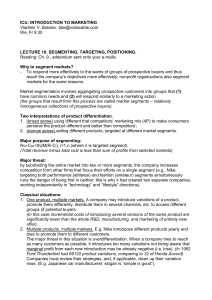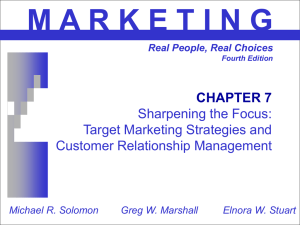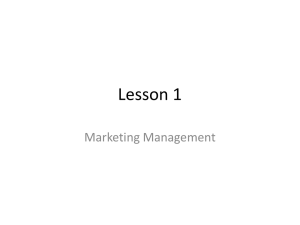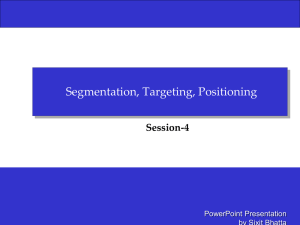Summary of Key Points for Chapter 5
advertisement
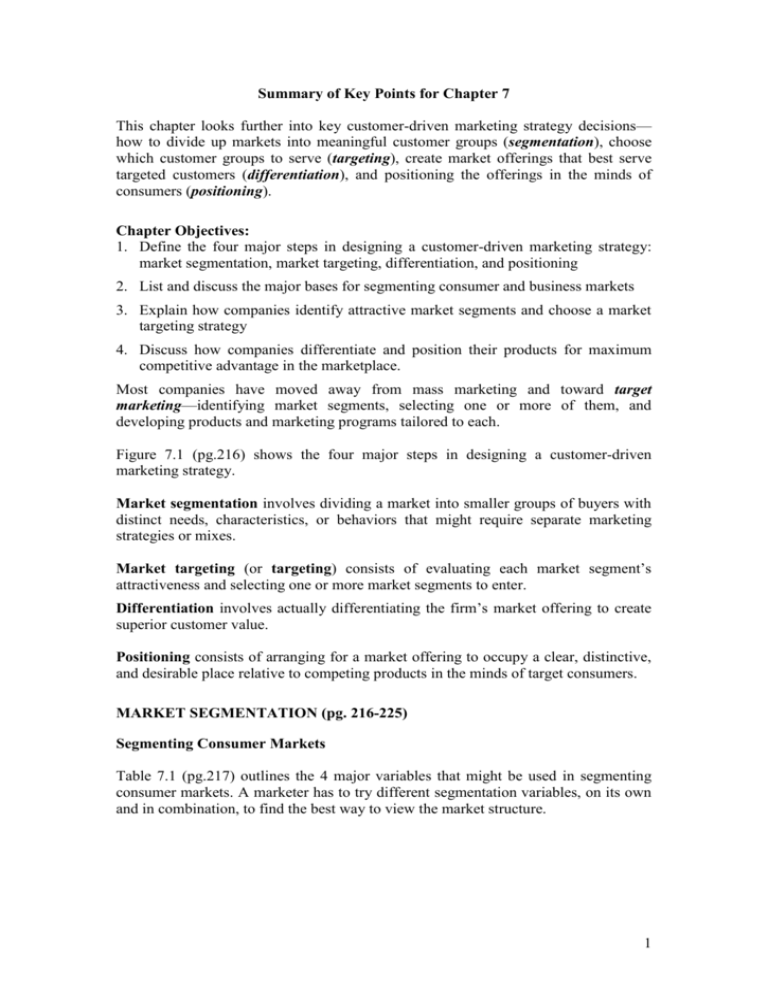
Summary of Key Points for Chapter 7 This chapter looks further into key customer-driven marketing strategy decisions— how to divide up markets into meaningful customer groups (segmentation), choose which customer groups to serve (targeting), create market offerings that best serve targeted customers (differentiation), and positioning the offerings in the minds of consumers (positioning). Chapter Objectives: 1. Define the four major steps in designing a customer-driven marketing strategy: market segmentation, market targeting, differentiation, and positioning 2. List and discuss the major bases for segmenting consumer and business markets 3. Explain how companies identify attractive market segments and choose a market targeting strategy 4. Discuss how companies differentiate and position their products for maximum competitive advantage in the marketplace. Most companies have moved away from mass marketing and toward target marketing—identifying market segments, selecting one or more of them, and developing products and marketing programs tailored to each. Figure 7.1 (pg.216) shows the four major steps in designing a customer-driven marketing strategy. Market segmentation involves dividing a market into smaller groups of buyers with distinct needs, characteristics, or behaviors that might require separate marketing strategies or mixes. Market targeting (or targeting) consists of evaluating each market segment’s attractiveness and selecting one or more market segments to enter. Differentiation involves actually differentiating the firm’s market offering to create superior customer value. Positioning consists of arranging for a market offering to occupy a clear, distinctive, and desirable place relative to competing products in the minds of target consumers. MARKET SEGMENTATION (pg. 216-225) Segmenting Consumer Markets Table 7.1 (pg.217) outlines the 4 major variables that might be used in segmenting consumer markets. A marketer has to try different segmentation variables, on its own and in combination, to find the best way to view the market structure. 1 Geographic Segmentation: Geographic segmentation calls for dividing the market into different geographical units such as nations, regions, states, counties, cities, or even neighborhoods. A company must pay attention to geographical differences in needs and wants. Demographic Segmentation: Demographic segmentation divides the market into groups based on variables such as age, gender, family size, family life cycle, income, occupation, education, religion, race, generation, and nationality. Demographic factors are the most popular bases for segmenting customer groups. This helps marketers to assess the size of the target market and ‘reach’ it efficiently. Age and Life-Cycle Stage is offering different products or using different marketing approaches for different age and life-cycle groups. Gender segmentation has long been used in clothing, cosmetics, toiletries, and magazines. Income segmentation has long been used by the marketers of products and services such as automobiles, clothing, cosmetics, financial services, and travel. Psychographic Segmentation: Psychographic segmentation divides buyers into different groups based on social class, lifestyle, or personality characteristics. Marketers use personality variables to segment markets. Behavioral Segmentation: Behavioral segmentation divides buyers into groups based on their knowledge, attitudes, uses, or responses to a product. Occasion segmentation is grouping buyers according to occasions when they get the idea to buy, actually make their purchase, or use the purchased item. Benefit segmentation (Benefits sought) is grouping buyers according to the different benefits that they seek from the product. User Status is segmenting markets into nonusers, ex-users, potential users, first-time users, and regular users of a product. Usage Rates is grouping markets into light, medium, and heavy product users. Loyalty Status is dividing buyers into groups according to their degree of loyalty. Segmenting Business Markets Consumer and business marketers use many of the same variables to segment their markets. Business marketers also use some additional variables, such as customer operating characteristics, purchasing approaches, situational factors, and personal characteristics. 2 Many marketers believe that buying behavior and benefits provide the best basis for segmenting business markets. Segmenting International Markets Companies can segment international markets using one or a combination of several variables. Geographic factors: Nations close to one another will have many common traits and behaviors. Economic factors: Countries may be grouped by population income levels or by their overall level of economic development. Political and legal factors: Type and stability of government, receptivity to foreign firms, monetary regulations, and the amount of bureaucracy. Cultural factors: Grouping markets according to common languages, religions, values and attitudes, customs, and behavioral patterns. Intermarket segmentation is segmenting of consumers who have similar needs and buying behavior even though they are located in different countries e.g. IKEA targets the aspiring global middle class. Requirements for Effective Segmentation To be useful, market segments must be: Measurable: The size, purchasing power, and profiles of the segments can be measured. Accessible: The market segments can be effectively reached and served. Substantial: The market segments are large or profitable enough to serve. Differentiable: The segments are conceptually distinguishable and respond differently to different marketing mix elements and programs. Actionable: Effective programs can be designed for attracting and serving the segments. MARKET TARGETING (pg 225-233) Evaluating Market Segments: In evaluating different market segments, a firm must look at three factors: 1. Segment size and growth, 2. Segment structural attractiveness, and 3. Company objectives and resources. Segment size & growth: The largest, fastest-growing segments are not always the most attractive ones for every company. Smaller companies may find these segments too competitive. 3 Segment structural attractiveness: The company also needs to examine major structural factors that affect long-run segment attractiveness. A segment is less attractive if it already contains many strong and aggressive competitors. The existence of many actual or potential substitute products may limit prices and the profits. The relative power of buyers also affects segment attractiveness. A segment may be less attractive if it contains powerful suppliers who can control prices. Company objectives and resources: Some attractive segments may not align with the company’s objectives and resources. Or, the company may lack the skills & resources. Selecting Target Market Segments (Read Real Marketing 7.1-pg 27-228) A target market consists of a set of buyers who share common needs or characteristics that the company decides to serve. Figure 7.2 (pg. 226) shows that companies can target very broadly, somewhere in between or target very narrowly. Undifferentiated Marketing Using an undifferentiated marketing (or mass-marketing) strategy, a firm might decide to ignore market segment differences and target the whole market with one offer. This mass-marketing strategy focuses on what is common in the needs of consumers rather than on what is different. Differentiated Marketing Using a differentiated marketing (or segmented marketing) strategy, a firm decides to target several market segments and designs separate offers for each. Concentrated Marketing Using a concentrated marketing (or niche marketing) strategy, instead of going after a small share of a large market, the firm goes after a large share of one or a few smaller segments or niches. It can market more effectively by fine-tuning its products, prices, and programs to the needs of carefully defined segments. It can market more efficiently, targeting its products or services, channels, and communications programs toward only consumers that it can serve best and most profitably. Though it can be highly profitable, it involves higher-than-normal risks. Micromarketing Micromarketing is the practice of tailoring products and marketing programs to suit the tastes of specific individuals and locations. 4 Micromarketing includes local marketing and individual marketing. Local marketing involves tailoring brands and promotions to the needs and wants of local customer groups—cities, neighborhoods, and even specific stores. Local marketing has drawbacks. It can drive up manufacturing and marketing costs by reducing economies of scale. It can create logistics problems. The brand’s overall image might be diluted if the product and message vary too much in different localities. Individual marketing is the tailoring of products and marketing programs to the needs and preferences of individual customers. Individual marketing has also been labeled one-to-one marketing, mass customization, and markets-of-one marketing. Choosing a Targeting Strategy Which strategy is best depends on: Company resources. Product variability. Product’s life-cycle stage. Market variability. Competitors’ marketing strategies. DIFFERENTIATION AND POSITIONING (pg 233) Value proposition: How a company will create differentiated value for targeted segments and what positions it wants to occupy in those segments. A product’s position is the way the product is defined by consumers on important attributes. Positioning Maps (e.g. Fig. 7.3, pg. 234 for the US large luxury sport utility vehicle market). The position of each circle on the map indicates the brand’s perceived positioning on 2 dimensions (Price and Orientation i.e. luxury vs. performance). The size of each circle indicates the brand’s relative market share. Perceptual positioning maps show marketers consumer perceptions of their brands versus competing products on important buying dimensions. Choosing a Differentiation and Positioning Strategy The differentiation and positioning task consists of three steps: 5 1. Identifying a set of differentiating competitive advantages upon which to build a position, 2. Choosing the right competitive advantages, and 3. Selecting an overall positioning strategy. 1. Identifying Possible Value Differences and Competitive Advantages To the extent that a company can differentiate and position itself as providing superior customer value, it gains competitive advantage. It can differentiate along the lines of product, services, channels, people, or image. 2. Choosing the Right Competitive Advantages How Many Differences to Promote Ad man Rosser Reeves believes a company should develop a unique selling proposition (USP) for each brand (based on a single attribute) and stick to it. E.g. Wal-Mart promotes its always low prices. Other marketers think that companies should position themselves on more than one differentiator. E.g. Pledge is positioned as a multi-surface cleaner. Which Differences to Promote A difference is worth establishing to the extent that it satisfies the following criteria: Important: The difference delivers a highly valued benefit to target buyers. Distinctive: Competitors do not offer the difference, or the company can offer it in a more distinctive way. Superior: The difference is superior to other ways that customers might obtain the same benefit. Communicable: The difference is communicable and visible to buyers. Preemptive: Competitors cannot easily copy the difference. Affordable: Buyers can afford to pay for the difference. Profitable: The company can introduce the difference profitably. 3. Selecting an Overall Positioning Strategy The full positioning of a brand is called the brand’s value proposition. (See Figure 7.4, pg 239). More for More positioning involves providing the most upscale product or service and charging a higher price to cover the higher costs. More for the Same positioning involves introducing a brand offering comparable quality but at a lower price. The Same for Less positioning can be a powerful value proposition—everyone likes 6 a good deal. Less for Much Less positioning is offering products that offer less and therefore cost less. “Less-for-much-less” positioning involves meeting consumers’ lower performance or quality requirements at a much lower price. More for Less positioning is the winning value proposition. Communicating and Delivering the Chosen Position Once it has chosen a position, the company must take strong steps to deliver and communicate the desired position to target consumers. All the company’s marketing mix efforts (4 Ps) must support its positioning strategy. End-of-Week Questions: Name and describe the four major sets of variables that might be used in segmenting consumer markets. Which segmenting variable(s) do you think Starbucks is using? 7
